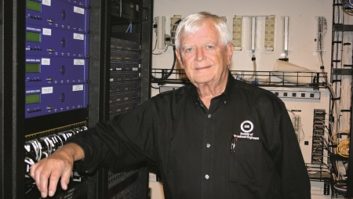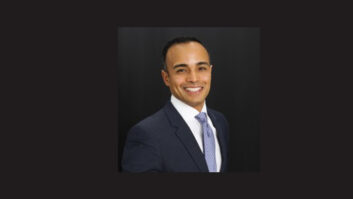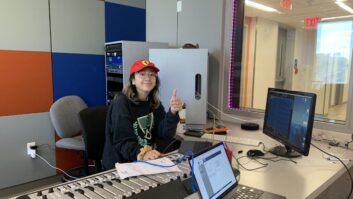SYRACUSE, N.Y. Vincent Lopez, new president of the Society of Broadcast Engineers, is a TV guy — always has been and likely always will be.
He is director of engineering for Sinclair Broadcast Group’s WSYT(TV) and WNYS(TV) in Syracuse, N.Y. However, like many TV broadcast engineers, Lopez has a keen interest in radio. He even has a radio studio in his basement and uses it frequently.
“I do some killer 1960s-era Drake format recreations,” said Lopez, whose SBE certifications are as Certified Video Engineer and Certified Broadcast Networking Technologist.

Lopez installs the strobe controller for a tower for WNYS(TV) and WSYT(TV). The stations, owned by Sinclair Broadcast Group, are in Syracuse. The home radio studio will also serve as the site for some Webcasts the new president plans to commence covering topics of importance to society members.
“My goal as president of SBE is to leverage technology to provide our members with more educational, informational and networking opportunities, and to continue with our EAS and regulatory efforts,” Lopez said. “I want to work to show (broadcast) management that engineers are valued members of their team and the broadcast community.”
The Society of Broadcast Engineers, a professional organization of television and radio engineers with approximately 5,300 members in 114 chapters, has played a huge role in Lopez’s professional career. He started attending SBE Chapter 22 meetings in Syracuse after visiting one of the chapter’s fall conventions.
“I started to meet and network with people I met at the show. There were a bunch of terrific guys running the chapter then. I learned a lot from Jim Bernier, now with Turner Networks in Atlanta, Jim Peck with SCMS, and Conrad Trautmann, now with Dial Global in New York City, during those early meetings,” he said.
Lopez, a member of SBE since 1991, held the positions of secretary, vice chair and then chairman at SBE 22 in Central State New York.
“I look on this experience (of being national president) the same way as leading Chapter 22, but on a national level. I’m working with an excellent board of directors and hope to learn a lot from them.”
Life-long learning
Lopez began his one-year term with the nonprofit organization in October. He has been a member of the national SBE board of directors since 2000, most recently serving as vice president. Lopez succeeds Barry Thomas.
The national SBE board is responsible for the development of policy and determines the programs and services the society provides its members, Lopez said, with the focus remaining on education.
The SBE recently hired Kimberly Kissell to grow SBE educational initiatives, specifically, the group’s online educations lineup.
“We are expanding the course content of SBE University and are hoping the make the Leader Skills course available online in a revised format,” Lopez said. SBE also will continue its RF Safety course online.
The radio industry’s technical challenges, including HD Radio, will continue to be addressed by SBE, Lopez said.
“HD Radio is in many ways similar to the DTV conversion that (TV) just went through. There were a lot of unknowns and technical challenges to overcome. Many SBE members stepped up to provide education and information, not only to the public but to fellow engineers. SBE University will be one of the tools we’ll use to help engineers and the industry.
“SBE prides itself on developing the best customer service professionals in the industry. We listen to the need of our customers and respond enthusiastically with creative solutions to build long-term relationships,” Lopez said.
As the radio industry and FCC consider boosting HD Radio power levels, the SBE’s work in the area will be directed at “providing the vital information, training and certification through our DRB specialist certification, publications such as ‘HD Radio Implementation’ and on-demand courses through SBE University,” Lopez said.
The organization is watching the Federal Emergency Management Agency’s development of an improved Emergency Alert System closely, Lopez said. At its October board meeting, SBE voted to join OASIS, a worldwide standards organization FEMA has selected to set standards for the next generation of EAS.
“Look at the track record of the past and current systems — CONELRAD, EBS, EAS. Each one was better than its predecessor, but still not good enough to do the job needed,” Lopez said. “The designers of the next-generation EAS need to look at this and go forward to create a comprehensive useful warning system.”
Work also continues at SBE on the so-called “white spaces” debate, which Lopez said could have a huge impact on radio and television broadcasters.
“Our specific emphasis is related to the broadcast auxiliary services [BAS] because of or important frequency coordination program,” Lopez said. “We know broadcast engineers will be left to pick up the pieces if many of the current plans proceed. Therefore, we have been active in education and advocacy on this issue.”

New SBE President Vincent Lopez Technology companies continue to lobby the FCC for permission to use so-called white space in the broadcast spectrum between allotted channels. Broadcasters have long expressed concern over increased interference, those familiar with the issue said.
The economy remains a concern for SBE as broadcast groups examine and reexamine every capital expenditure, Lopez said, forcing stations to identify efficiencies in workflows that allow them to make it easier for employees to remain productive while maintaining high standards.
Industry contractions
“What that boils down to is a need for every engineer to have good interpersonal skills with the rest of the team at their stations or facilities. SBE continues to offer our Leader Skills Seminar, which teaches engineers people skills that they can take with them back to their stations to put into practice,” Lopez said.
SBE noted the announcement by Gap Broadcasting and Cumulus Media this year that the two groups will share engineering resources and engineers in four of their radio markets in an effort to reduce costs, Lopez said (Radio World, Oct. 7). The move essentially took work that had been done by one or more contract engineers in each market and moved it to a full-time Gap or Cumulus employee. Gap eliminated one full-time engineering position at one radio station in those markets. Similar agreements between other broadcast groups could eliminate more positions by combining jobs, Lopez said.
“First of all, we do realize that any business needs to run so that it can continue to profit and exist. However, ownership must realize that good engineering is valuable to their bottom line and needs to be considered in any strategic decisions moving forward.
“I do think these kinds of arrangements will become more common, especially in smaller markets. Again, this demonstrates the need for engineering professionals to continue their education in the newest technologies to keep their skill set current.”
Lopez, 47, is single and lives in Syracuse. He has an associate of applied science degree in radio and television from Onondaga Community College there and attended Syracuse University.
He began his television engineer career in 1983 at NewsChannels Cable in Syracuse working in production, and became Master Control operator at WSYT(TV) in Syracuse in 1987 and then Master Control supervisor in 1988. He moved into engineering in 1997 and became WSYT director of engineering in 2005.
Also elected to 2009–2010 SBE offices are Ralph Hogan, CPBE, DRB, CBNT, director of engineering for KJZZ(FM) and KBAQ(FM) in Tempe, Ariz., as vice president and Ted Hand, CPBE, AMD, 8-VSB, the chief engineer for WSOC(TV) and WAXN(TV) in Charlotte, N.C. as secretary.
Elected to a term as treasurer is Andrea Cummis, CBT, CTO, consultant and project manager for Media Project Partners in Roseland, N.J.












